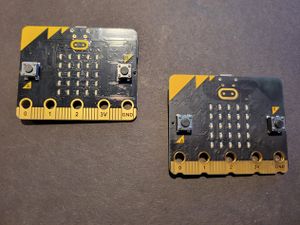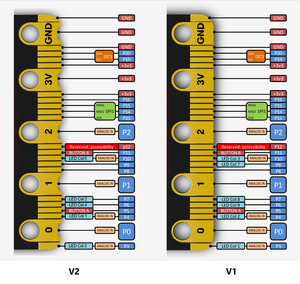Micro:bit: Difference between revisions
(Created page with "'''micro:bit''' The micro:bit is a small programmable computer developed for education and experimentation. It was created by the BBC to encourage coding and digital skills in young people. The device is pocket-sized, measuring 4cm x 5cm, and includes an LED display, buttons, sensors, microprocessor, Bluetooth, and a built-in battery pack. It can be programmed with Microsoft MakeCode, Python, Scratch, and JavaScript. The micro:bit is easy to use and comes with tutorials...") |
No edit summary |
||
| (12 intermediate revisions by the same user not shown) | |||
| Line 1: | Line 1: | ||
[[File:Microbit logo.png|thumb|right|The micro:bit logo.]] | |||
The micro:bit is a small programmable computer developed for education and experimentation. It was created by the BBC to encourage coding and digital skills in young people. | [[File:Microbits.jpg|thumb|right|Two micro:bits. Notice that the v2 example on the right has small notches along the bottom edge to distinguish it from v1.]] | ||
[[File:Microbit pins.png|thumb|right|micro:bit pinout for versions one and two.]] | |||
The '''micro:bit''' is a small programmable computer developed for education and experimentation. It was created by the BBC to encourage coding and digital skills in young people. | |||
There are two versions of the micro:bit: version 1 and version 2. Both versions are similar in many ways, but there are some key differences between the two. | |||
==v1== | |||
Overall, the micro:bit v1 is a small and affordable device designed for education and experimentation in programming and electronics. Its compact size, variety of sensors and input/output options, and wireless capabilities make it a versatile tool for a wide range of projects. | |||
* Processor: 16MHz ARM Cortex-M0 | |||
* Memory: 16KB RAM, 256KB Flash | |||
* Wireless: Bluetooth Low Energy (BLE) | |||
* Sensors: Compass, Accelerometer, and Temperature sensor | |||
* Input/Output: 5x5 LED matrix display, 2 programmable buttons, 3 analog input/output rings, 20-pin edge connector for additional accessories | |||
* Power: Micro USB connector for power and programming, or 2 AAA batteries (not included) | |||
[https://makecode.microbit.org/v1/device/pins Diagram of micro:bit v1] | |||
==v2== | |||
Compared to the micro:bit v1, the v2 has a more powerful processor, more memory, and additional features such as a microphone, speaker, touch-sensitive logo, and capacitive touch sensor. These enhancements make the micro:bit v2 more capable of handling complex tasks and enable more advanced projects and experimentation with sound and touch-based interactions. | |||
* Processor: 64MHz ARM Cortex-M4 | |||
* Memory: 512KB RAM, 2MB Flash | |||
* Wireless: Bluetooth Low Energy (BLE) | |||
* Sensors: Compass, Accelerometer, and Temperature sensor | |||
* Input/Output: 5x5 LED matrix display, 2 programmable buttons, touch-sensitive logo, capacitive touch sensor, 25-pin edge connector for additional accessories | |||
* Sound: Speaker and microphone | |||
* Power: Micro USB connector for power and programming, or 2 AAA batteries (not included) | |||
Despite these differences, both versions of the micro:bit are great tools for learning to code and experimenting with electronics. They are easy to use, affordable, and come with a range of resources and tutorials to help beginners get started. | |||
[https://makecode.microbit.org/v2/device/pins Diagram of micro:bit v2] | |||
==External Links== | |||
* [https://microbit.org/ The micro:bit home page.] | |||
* [https://www.youtube.com/watch?v=XDQi2P8s_hI YouTube video of the finished product of one of the tutorials I followed.] | |||
* [https://www.amazon.com/gp/product/B07TKHNDQQ Adeept BBC Micro:bit Sensor Starter Kit] | |||
* [https://www.amazon.com/gp/product/B09YRDW7GS FREENOVE Basic Starter Kit for BBC Micro:bit] | |||
[[Category:Tech]] | |||
[[Category:micro:bit]] | |||
Latest revision as of 17:10, 30 April 2023
The micro:bit is a small programmable computer developed for education and experimentation. It was created by the BBC to encourage coding and digital skills in young people.
There are two versions of the micro:bit: version 1 and version 2. Both versions are similar in many ways, but there are some key differences between the two.
v1
Overall, the micro:bit v1 is a small and affordable device designed for education and experimentation in programming and electronics. Its compact size, variety of sensors and input/output options, and wireless capabilities make it a versatile tool for a wide range of projects.
- Processor: 16MHz ARM Cortex-M0
- Memory: 16KB RAM, 256KB Flash
- Wireless: Bluetooth Low Energy (BLE)
- Sensors: Compass, Accelerometer, and Temperature sensor
- Input/Output: 5x5 LED matrix display, 2 programmable buttons, 3 analog input/output rings, 20-pin edge connector for additional accessories
- Power: Micro USB connector for power and programming, or 2 AAA batteries (not included)
v2
Compared to the micro:bit v1, the v2 has a more powerful processor, more memory, and additional features such as a microphone, speaker, touch-sensitive logo, and capacitive touch sensor. These enhancements make the micro:bit v2 more capable of handling complex tasks and enable more advanced projects and experimentation with sound and touch-based interactions.
- Processor: 64MHz ARM Cortex-M4
- Memory: 512KB RAM, 2MB Flash
- Wireless: Bluetooth Low Energy (BLE)
- Sensors: Compass, Accelerometer, and Temperature sensor
- Input/Output: 5x5 LED matrix display, 2 programmable buttons, touch-sensitive logo, capacitive touch sensor, 25-pin edge connector for additional accessories
- Sound: Speaker and microphone
- Power: Micro USB connector for power and programming, or 2 AAA batteries (not included)
Despite these differences, both versions of the micro:bit are great tools for learning to code and experimenting with electronics. They are easy to use, affordable, and come with a range of resources and tutorials to help beginners get started.


